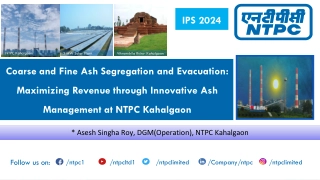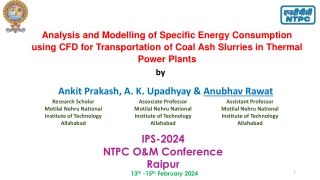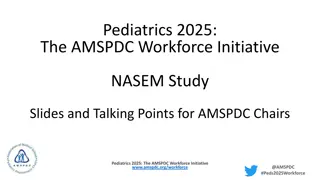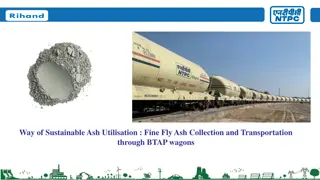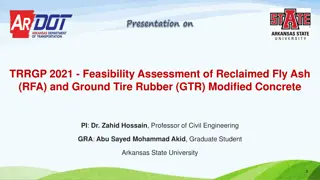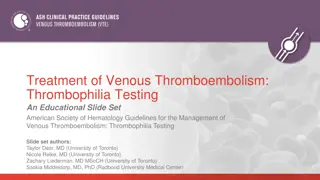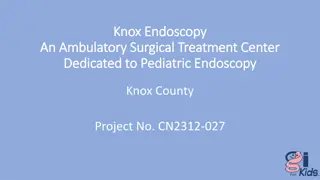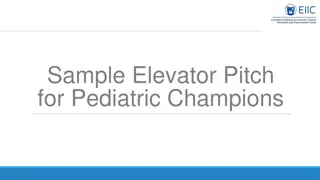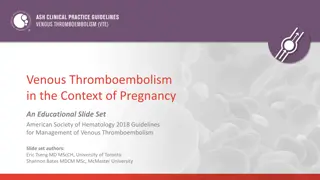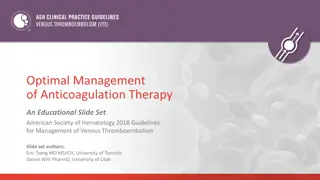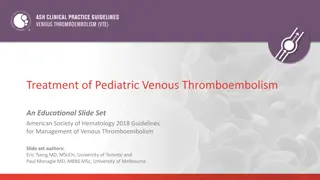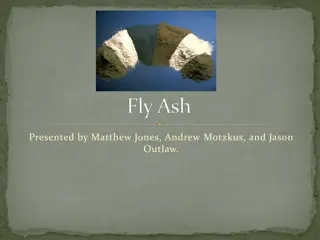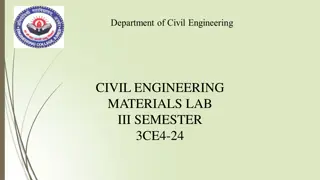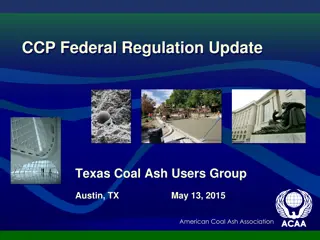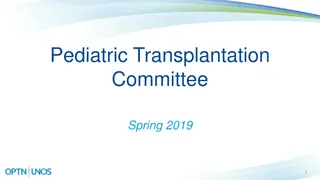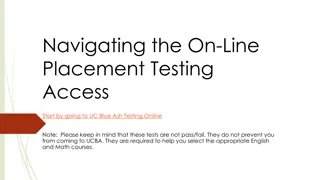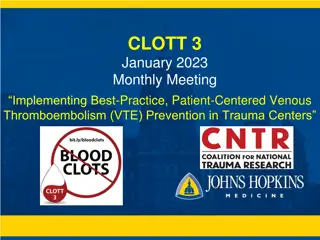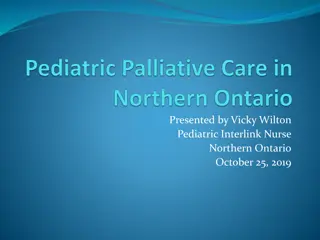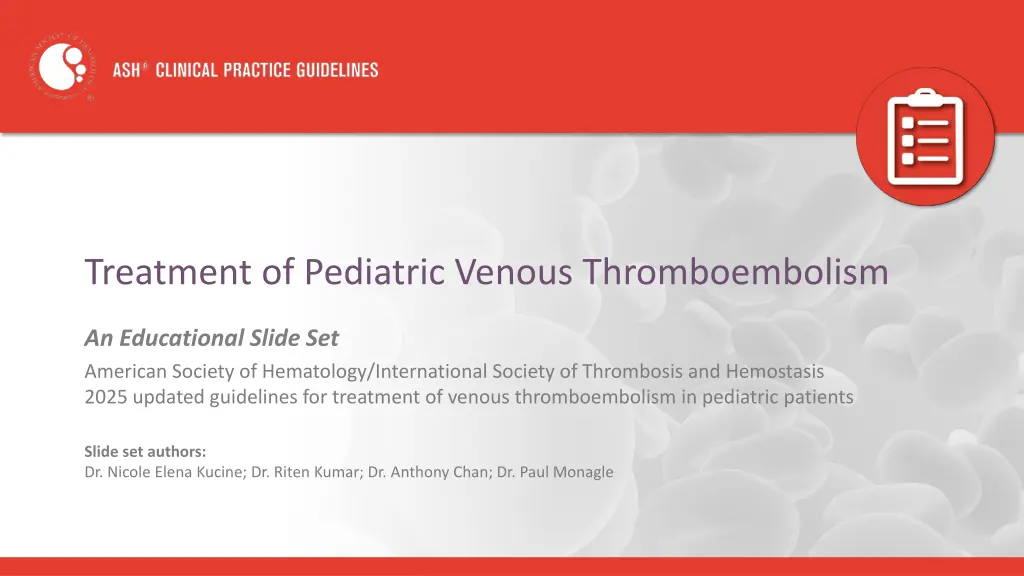
Pediatric Venous Thromboembolism Guidelines Updated 2025
Learn about the updated 2025 guidelines for treating pediatric venous thromboembolism endorsed by the American Society of Hematology/International Society of Thrombosis and Hemostasis. Explore key aspects such as panel formation, clinical questions, evidence synthesis, recommendation methodology, and the history of pediatric VTE guidelines. Understand the process of guideline updates and ensure evidence-based treatment strategies for pediatric patients with VTE.
Download Presentation

Please find below an Image/Link to download the presentation.
The content on the website is provided AS IS for your information and personal use only. It may not be sold, licensed, or shared on other websites without obtaining consent from the author. If you encounter any issues during the download, it is possible that the publisher has removed the file from their server.
You are allowed to download the files provided on this website for personal or commercial use, subject to the condition that they are used lawfully. All files are the property of their respective owners.
The content on the website is provided AS IS for your information and personal use only. It may not be sold, licensed, or shared on other websites without obtaining consent from the author.
E N D
Presentation Transcript
Treatment of Pediatric Venous Thromboembolism An Educational Slide Set American Society of Hematology/International Society of Thrombosis and Hemostasis 2025 updated guidelines for treatment of venous thromboembolism in pediatric patients Slide set authors: Dr. Nicole Elena Kucine; Dr. Riten Kumar; Dr. Anthony Chan; Dr. Paul Monagle
American Society of Hematology International Society on Thrombosis and Haemostasis 2025 updated guidelines for treatment of venous thromboembolism in pediatric patients Paul Monagle, Muayad Azzam, Rachel Bercovitz, Marisol Betensky, Rukhmi Bhat, Tina Biss, Brian Branchford, Leonardo R. Brandao, Anthony KC Chan, E Vincent S Faustino, Julie Jaffray, Sophie Jones, Hassan Kawtharany, Bryce Kerlin, Nicole Kucine, Riten Kumar, Christoph Male, Marie-Claude Pelland- Marcotte, Leslie Raffini, Chittalsinh Raulji, Sarah E Sartain, Clifford M. Takemoto, Cristina Tarango, C. Heleen vVan Ommen, Maria C. Velez -Yanguas, Sara K. Vesely, John Wiernikowski, Suzan Williams, Hope Wilson, Gary Woods, Ayesha Zia, Reem A. Mustafa.
ASH Clinical Practice Guidelines on VTE 1. Prevention of VTE in Surgical Hospitalized Patients 2. Prevention of VTE in Medical Hospitalized Patients 3. Treatment of Acute VTE (DVT and PE) 4. Optimal Management of Anticoagulation Therapy 5. Prevention and Treatment of VTE in Patients with Cancer 6. Heparin-Induced Thrombocytopenia (HIT) 7. Thrombophilia 8. Pediatric VTE 9. VTE in the Context of Pregnancy 10. Diagnosis of VTE
History of VTE Pediatrics Guideline ASH originally published guidelines for treatment of pediatric VTE in 2018. These guidelines were updated in 2025 in response to new pediatric data published over the preceding 4 years. 2018 2019 2020 2021 2022 2023 2024 2025 ASH released first guideline on treatment of pediatric VTE New pediatric data published, specifically related to use of DOACs in children Guideline update begins Updated Pediatric VTE guideline published.
How were these guidelines updated? PANEL FORMATION Guideline panel was formed following these key criteria: Balance of expertise (including disciplines beyond hematology) Close attention to minimization and management of conflicts of interest CLINICAL QUESTIONS 20 clinically-relevant questions generated in PICO format (population, intervention, comparison, outcome) EVIDENCE SYNTHESIS Evidence summary generated for each PICO question via systematic review of health effects plus: Resource use Feasibility Acceptability Equity Patient values and preferences MAKING RECOMMENDATIONS Recommendations made by guideline panel members based on evidence for all factors. Example: PICO question Should anticoagulation versus no therapy be used in neonates with renal vein thrombosis? ASH guidelines are reviewed annually by expert work groups convened by ASH. Resources, such as this slide set, derived from guidelines that require updating are removed from the ASH website.
How patients and clinicians should use these recommendations STRONG Recommendation CONDITIONAL Recommendation The panel recommends The panel The panel suggests against The panel suggests recommends against A majority would want the intervention, but many would not. For patients Most individuals would want the intervention. Different choices will be appropriate for different patients, depending on their values and preferences. Use shared decision making. For clinicians Most individuals should receive the intervention.
Objectives By the end of this session, you should be able to 1. Describe recommendations for the duration of anticoagulant treatment of provoked VTE in children 2. Describe recommendations for the use of DOACs in children 3. Describe recommendations for the management of symptomatic and asymptomatic VTE in children
Pediatric venous thrombosis is a disease primarily of sick children VTE in the general pediatric population is rare (0.07 to 0.14 per 10,000 children) The rate of VTE in children is increased by 100 to 1,000 times in hospitalized children The most common precipitating factor is the presence of CVAD* which are related to 80-85% of pediatric VTE There are now 3 anticoagulant drugs approved for use in children *CVAD = central venous access device
What is different in this updated guideline Whether to treat and what type of treatment in different scenarios Includes discussion on duration and type of anticoagulation Anticoagulation (AC) refers to unfractionated heparin (UFH), low molecular weight heparin (LMWH), fondaparinux, vitamin K antagonists (VKA), and direct oral anticoagulants (DOACs) - rivaroxaban and dabigatran
Case 1: Provoked VTE in a child A 20-month-old toddler is admitted to the pediatric ICU with RSV and respiratory failure There is no personal or family history of thrombosis The patient is intubated, and a left femoral CVAD is placed 2 days after admission he develops left lower extremity swelling
Case 1: Provoked VTE in a child Doppler ultrasound (US): occlusive thrombus is seen around the catheter in the common femoral vein - Provoked VTE Anticoagulation is started Since the line is working and still necessary, it is left in place until just prior to discharge Anticoagulation continues after hospital discharge On follow-up at 6 weeks - swelling has resolved on physical exam, and an US with doppler shows a small segment of residual non-occlusive thrombus
This child has a provoked VTE. His risk factors for the thrombus are resolved, and the clot has partially resolved and there is no longer occlusive thrombus. How would you manage his VTE at this point? A. Continue anticoagulation for a total of 3 months and then discontinue B. Discontinue anticoagulation now that 6 weeks of treatment are completed C. Continue treatment until thrombus resolves completely on US D. Surgical thrombectomy
Recommendation The ASH/ISTH guideline panel suggests 6 weeks rather than 3 months of anticoagulation in select pediatric patients with provoked VTE Notes: This recommendation is based largely on the KIDS-DOTT* study evaluating treatment duration for provoked-VTE There were stringent inclusion/exclusion criteria and many children with provoked VTE were excluded Patients are excluded from this recommendation if they have: Pulmonary embolism Cancer associated VTE Recurrent VTE Persistent provoking risk factors Major thrombophilia Children with persistent occlusive thrombus at 6 weeks were not randomized in the KIDS-DOTT study and are excluded from this recommendation Children with persistent positive antiphospholipid antibodies (APA) at 6 weeks were not randomized in the KIDS-DOTT study and are excluded from this recommendation *Goldenberg N, et al; JAMA, 2022
Recommendation The Kids-DOTT study demonstrated non-inferiority of 6 weeks of anticoagulation vs 3 months, based on outcomes of: Recurrent thrombosis Clinically relevant bleeding Due to low numbers of events, relative effects were not estimable for: Risk of clinically relevant bleeding (6 weeks = 0.65% vs 3 months = 0.70%) Symptomatic recurrent VTE (6 weeks = 0.6% vs 3 months = 1.4%) Mortality (6 weeks = 1.9% vs 3 months = 1.9%)
Recommendation The certainty of evidence for benefits, harms, and burden was considered low due to serious imprecision Conditional recommendation The panel recognized that there may be benefits related to Quality of life with a shortened duration of therapy (especially for those receiving subcutaneous injections) Increasing acceptability and feasibility of the intervention Potential for moderate cost benefits
A note about thrombophilia testing In the KIDS-DOTT study, all subjects had thrombophilia testing including APA Subjects with persistently positive APAs at 6 weeks were excluded from randomization The panel DOES NOT recommend thrombophilia testing in all pediatric patients with provoked VTE This is consistent with the ASH-ASPHO choosing wisely campaign which does not recommend testing in pediatric patients with CVAD-associated VTE Thrombophilia testing should be based on features such as clinical presentation and family history
Case 1: Conclusion The patient with provoked VTE had resolution of occlusive thrombus Given the resolution of provoking factors and symptoms, discontinuation of anticoagulation at this time is appropriate He continues to do well clinically and a follow-up ultrasound at 1 year shows no residual thrombosis
Case 1: Summary It is now suggested that for many pediatric patients with provoked VTE, 6 weeks of anticoagulation treatment is an appropriate treatment course Children with PE, recurrent VTE, persistent occlusive thrombus, cancer-associated VTE, persistent APAs or major thrombophilia, or ongoing provoking risk factors for VTE are excluded from this new recommendation Future areas of study should include identifying additional patient groups who may benefit from 6 weeks of anticoagulation, and real-world data on DOACs for shortened duration of therapy While DOACs are not excluded from this recommendation, the majority of children in KIDS-DOTT were treated with LMWH
Case 2: Choice of anticoagulant A 14 year old, previously healthy female presents to the Emergency Department with acute onset dyspnea, cough and chest pain Vitals are notable for tachycardia, tachypnea with normal blood pressure Past medical history: dysmenorrhea for which she was started on a combined oral contraceptive pill 3-months ago Family history: negative for venous thrombo-embolism
Case 2: Choice of anticoagulant CT Pulmonary Angiogram: B/L segmental and subsegmental pulmonary embolism Echocardiogram: No evidence of right-sided heart strain Troponin and pro-BNP levels: Normal Patient was admitted to the hospital and anticoagulation with LMWH was started. Gynecology referral was made to discuss appropriate alternative long-term menstrual management. Chest pain and dyspnea improve over the next 3 days
Patient has provoked standard-risk PE (i.e. no echocardiographic or biochemical evidence of right ventricular dysfunction, and no evidence of hemodynamic compromise). She has now completed 5-days of anticoagulation with LMWH Which anticoagulant would you recommend for the ongoing management of this patient? A. Continue LMWH for a total duration of 3-6 months B. Transition the patient to rivaroxaban to complete 3-6 months C. Transition the patient to dabigatran to complete 3-6 months D. Transition the patient to VKA to complete 3-6 months Both are reasonable options
Recommendation 17 The ASH/ISTH guideline panel suggests using DOACs (Rivaroxaban/Dabigatran) over standard of care anticoagulants (LMWH, UFH, VKA, Fondaparinux) in pediatric patients with VTE Remarks: Systematic review included 3 RCTs, 2 large multi-center trials and 1 small single-institution study 853 patients were recruited to these studies, of whom 523 received a DOAC (Rivaroxaban/Dabigatran) Rivaroxaban was dosed according to weight; Dabigatran dosed according to both age and weight The following patients were excluded from the RCTs - Severe liver and renal impairment Pre-term neonates (<37 weeks GA) Neonates/infants <3rd percentile for weight Active bleeding/high risk of bleeding In all the studies, patients received a minimum of 5-days of parenteral anticoagulation with SOC (i.e. unfractionated heparin, low molecular weight heparin or fondaparinux) before starting a DOAC (Rivaroxaban/Dabigatran).
Recommendation 17 Number of patients Effect Certainty of evidence about benefits and adverse events ranged from very low to low to moderate Outcomes DOAC SOC Relative (95% CI) Absolute (95% CI) RR: 0.71 (0.14 to 3.56) 2 fewer per 1000 (6 fewer to 19 more) Mortality 3/522 2/267 Length of follow up in the RCTs (3-6 months) was too short to accurately predict risk of post thrombotic syndrome RR: 0.43 (0.2 to 0.93) 30 fewer per 1000 (42 fewer to 4 fewer) Thrombus recurrence 11/523 14/267 RR: 1.09 (0.99 to 1.19) 64 more per 1000 (7 fewer to 135 more) Thrombus resolution 395/512 181/255 RR: 0.48 (0.14 1.57) 10 fewer per 1000 (16 fewer to 11 more) Major Bleeding 4/517 5/264 Clinically Relevant Non-Major Bleeding RR: 2.98 (0.67 13.27) 16 more per 1000 (3 fewer to 97 more) 12/506 2/252
Recommendation 18 The ASH/ISTH guideline panel suggests using rivaroxaban over standard of care anticoagulants (LMWH, UFH, VKA, Fondaparinux) in pediatric patients with venous thromboembolism (VTE). Recommendation 19 The ASH/ISTH guideline panel suggests using dabigatran over standard of care anticoagulants (LMWH, UFH, VKA, Fondaparinux) in pediatric patients with venous thromboembolism (VTE).
Recommendation 18 and 19 Small benefit of rivaroxaban over SOC with regards to reduced thrombus recurrence and improved thrombus resolution. Small benefit of dabigatran over SOC with regards to reduced thrombus recurrence and improved thrombus resolution. Undesirable effects of rivaroxaban namely an increase in clinically relevant non-major bleeding (CRNMB) was small. Undesirable effects of dabigtran were trivial. Remarks: Estimates were imprecise due to the small number of events and wide CI. Increased menstrual bleeding with rivaroxaban important consideration in adolescent females. 10% of patients in the Dabigatran arm of DIVERSITY trial taken off study since they failed to achieve an a-priori therapeutic levels.
Recommendation 20 The ASH/ISTH guideline panel suggests using either rivaroxaban or dabigatran in pediatric patients with venous thromboembolism (VTE) although there may be individual populations or jurisdictional availability that would lead clinicians to choose one agent over the other Remarks: DOACs orally administered avoiding the need for daily injections of LMWH Fewer drug interactions compared to VKA Do not require routine monitoring labs Access to these agents in low and middle-income countries needs to be addressed
Patient cohorts where DOACs should not be used/ used with great caution - Patients with anti-phospholipid antibody syndrome and mechanical valves Patients with known/potential gut absorption issues including short gut syndrome Recent surgery Liver disease (ALT >5x ULN and/or bilirubin >2x ULN)/ liver disease causing coagulopathy Renal disease (GFR <30 mL/min) Pre-term neonates Patients with active cancer
Case 2 Patient and her parents decide to transition to rivaroxaban Rivaroxaban 20 mg QHS is started after completing 5-days of LMWH Rivaroxaban is well tolerated with the exception of slightly heavy menstrual bleeding Follow up CTPA after 3-months of anticoagulation shows radiological thrombus resolution rivaroxaban is discontinued
Case 2 Summary Children with venous thromboembolism can be treated with direct oral anticoagulants (rivaroxaban/dabigatran) after 5days of initial parenteral treatment (UFH, LMWH or Fondaparinux) Either rivaroxaban or dabigatran may be used to treat pediatric venous thromboembolism In certain pediatric cohorts including anti-phospholipid antibody syndrome, active cancer, gut absorption issues, preterm neonates, severe liver and kidney disease, SOC may be preferred over DOACs till more evidence is available
Case 3: Anticoagulation for symptomatic DVT A 28-year-old female is admitted at 36 weeks of gestation and delivered fraternal twins Patient 1: Twin A Patient 2: Twin B
Case 3: Anticoagulation for symptomatic DVT Patient 1 : Twin A Twin A has respiratory distress and venous access was required Attempted umbilical venous line was not successful; a PICC was inserted He developed swelling of the right arm, and thus doppler US was done Ultrasound showed occlusive thrombi in axillary vein and subclavian vein PICC was functional and the patient still required vascular access
Case 3: Anticoagulation for symptomatic DVT Patient 1 : Twin A Question 1: Does the patient need to receive an anticoagulant, and can the PICC be removed? Patient treated with LMWH, PICC removed Patient treated with LMWH, PICC not removed Patient not treated with anticoagulant , PICC removed
Case 3: Anticoagulation for symptomatic DVT Patient 1 : Twin A Question 1: Does the patient need to receive an anticoagulant, and can the PICC be removed? Patient treated with LMWH, PICC removed Patient treated with LMWH, PICC not removed Patient not treated with anticoagulant , PICC removed The risk factor is not removed, and the patient is symptomatic, thus the patient is anticoagulated with LMWH Vascular access is necessary and PICC is functional, thus PICC is not removed
Case 3: Anticoagulation for symptomatic DVT Patient 1 : Twin A Patient received 5 days of LMWH and PICC is still required Question 2: should the patient be switched to a DOAC or continue to use LMWH? Continue LMWH Switch to DOAC
Case 3: Anticoagulation for symptomatic DVT Patient 1 : Twin A Patient received 5 days of LMWH and PICC is required Question 2: should the patient be switched to a DOAC or continue to use LMWH? Continue LMWH Switch to DOAC Neonates < 37 weeks gestation were excluded from phase 3 trials for the approved DOACs for children ( rivaroxaban, dabigatran ) and thus the patient stayed on LMWH
Case 3: Anticoagulation for symptomatic DVT Patient 1: Twin A PICC was not required at 2 weeks of age and PICC was removed Repeat US showed non-occlusive thrombus Swelling of arm improved Question 3: how long shall the patient stay on LMWH 4 weeks of LMWH 6 weeks of LMWH 3 months of LMWH
Case 3: Anticoagulation for symptomatic DVT Patient 1 : Twin A PICC was not required at 2 weeks of age and removed Repeat US showed no progress of thrombus Swelling of arm improved Question 3: how long shall the patient stay on LMWH 4 weeks of LMWH 6 weeks of LMWH 3 months of LMWH According to the Kids-DOTT trial, non occlusive thrombus with risk factors removed can be treated for 6 weeks However, in real-world experience and the Einstein Jr. trial, the treatment period is only 1 month for CVC related thrombus in < 2 years of age
Case 3: Anticoagulation for symptomatic DVT Patient 2 : Twin B Attempted umbilical venous line was not successful; a PICC was inserted Policy of the NICU was to do screening ultrasound for PICC before removal Ultrasound showed a non-occlusive thrombus in the subclavian vein with no symptoms
Case 3: Anticoagulation for symptomatic DVT Patient 2 : Twin B Question 4: Does the patient need to be treated, and can the PICC be removed? Patient treated with LMWH; PICC removed Patient treated with LMWH; PICC not removed Patient not treated with anticoagulant; PICC removed
Case 3: Anticoagulation for symptomatic DVT Patient 2: Twin B Question 4: Does the patient need to be treated, and can the PICC be removed? Patient treated with LMWH; PICC removed Patient treated with LMWH; PICC not removed Patient not treated with anticoagulant; PICC removed The PICC was removed since vascular access was NOT required The baby was NOT anticoagulated since the thrombus did not cause any symptoms, and the risk factor was removed Repeat US done after three days showing no thrombus; the patient remained asymptomatic
Recommendation #1 For pediatric patients with symptomatic DVT or PE, the ASH/ISTH Guideline Panel suggests using anticoagulation rather than no anticoagulation (conditional recommendation based on very low certainty in the evidence about effects.) Remarks: Although there remains limited direct evidence in pediatric patients, there is strong indirect evidence in adults that symptomatic VTE requires treatment. However, based on recently published observational studies in pediatric patients, there may be specific clinical scenarios such as neonatal central venous catheter (CVC)-associated VTE or trauma associated VTE where anticoagulation may result in either no significant benefit or potentially an increased risk of harm. Outside of these specific clinical scenarios, the panel agrees that in most pediatric patients with symptomatic DVT and PE, anticoagulation is warranted. Therefore, the panel made a conditional recommendation with low certainty of evidence.
Recommendation #2 The ASH/ISTH Guideline Panel suggests either using anticoagulation or no anticoagulation in pediatric patients with clinically unsuspected (previously termed asymptomatic) deep vein thrombosis (DVT) or pulmonary embolism (PE) (conditional recommendation based on very low certainty in the evidence about effects) Remarks: The natural history of clinically unsuspected DVT or PE in pediatric patients appears to carry a lower risk of acute and long-term sequelae, especially in certain pediatric sub-populations. The recommendation is based on studies that report outcomes for pediatric patients with clinically unsuspected DVT or PE. If clinically unsuspected DVT or PE is detected, the decision to treat or not treat should be individualized.
Case 3: Summary Anticoagulation is suggested for most pediatric patients with symptomatic DVT or PE, over no anticoagulation For clinically unsuspected DVT or PE, the benefits and harms of anticoagulation vary among populations and either anticoagulation or no anticoagulation may be appropriate. Future research should help to better understand the natural history of clinically unsuspected DVT or PE, benefits, and harms of treatment in a variety of subgroups and clinical settings in pediatrics.
Other guideline recommendations that were not covered in this session For these topics, conditional recommendations were made based on low or very low certainty of evidence Management of unprovoked DVT or PE Management of superficial vein thrombosis Management of VTE in specific locations (cerebral sinus venous thrombosis, right atrial thrombosis, portal vein thrombosis) Use of thrombolysis When to remove a central line in setting of line-associated VTE
Future Priorities for Research Risk stratification of pediatric subgroups who would benefit most and least from treatment Further studies on specific VTE types Further studies on thrombolysis Studies on DOACs in special populations (such as neonates and children with cancer) Studies on reversal agents for DOACs Studies on the need for 5+ days of parenteral therapy prior to starting DOACs
In Summary: Back to our Objectives 1. Describe recommendations for the duration of anticoagulant treatment of provoked VTE in children Anticoagulation for 6 weeks is suggested for many pediatric patients with provoked VTE 2. Describe recommendations for the use of DOACs in children Anticoagulation with DOACs (rivaroxaban/dabigatran) is suggested for pediatric patients with VTE after at least 5 days of heparin therapy 3. Describe recommendations for the management of symptomatic and asymptomatic VTE in children Anticoagulation is suggested for treatment of symptomatic VTE, but either anticoagulation or no anticoagulation may be appropriate in a child with asymptomatic VTE
Acknowledgements ASH Guideline Panel team members Knowledge Synthesis team members McMaster University GRADE Centre Authors of prior ASH VTE Slide Sets: Eric Tseng MD MScCH, University of Toronto and Paul Monagle MD MBBS MSc, University of Melbourne, Royal Children s Hospital Authors of current ASH VTE Slide Sets: Anthony Chan MD, Nicole Kucine MD MS Weill Cornell Medicine, Riten Kumar MD, MSc, Harvard Medical School. See more about the ASH VTE guidelines at hematology.org/VTEguidelines

